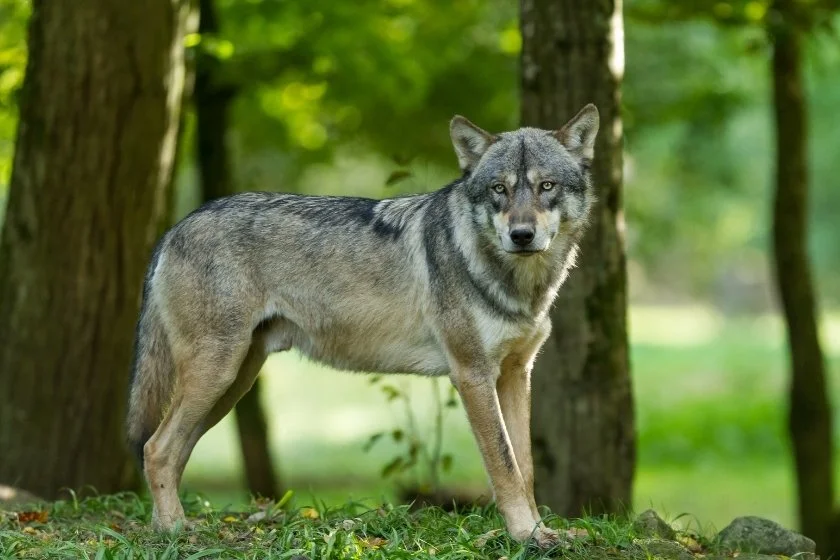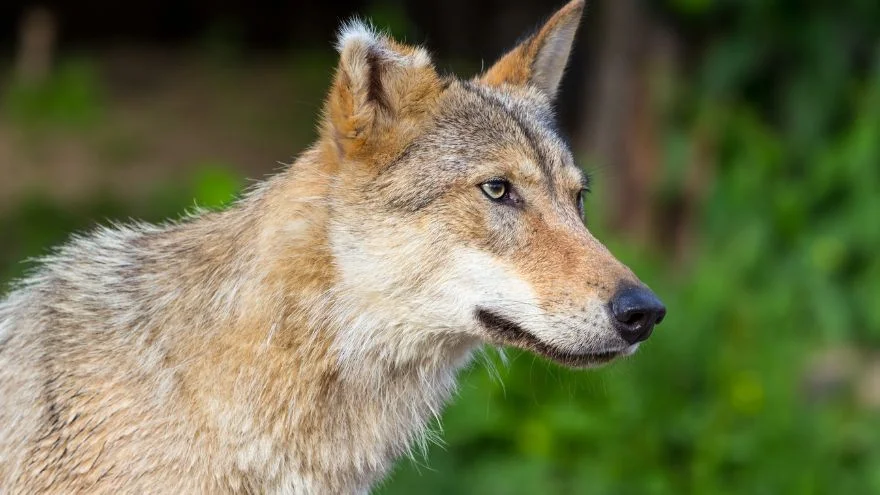Wolves classify as one of the endangered species in most parts of the United States. Over time, hostile human activities such as illegal hunting, trapping, and poisoning exposed these animals to danger.
The government has tried to preserve and reintroduce these endangered species through various activities. In light of these efforts by the government, one might wonder, are there wolves in Rhode Island wildlife?
Yes, there are wolves on Rhodes Island, though not as many as they used to be. In the past, wolves were fully present in some Northeastern parts of the United States, now known as Rhodes Island.
However, they were removed from this area alongside other mammals like bears and mountain lions.
Records showed that around 1703, wolves were so widespread in Rhodes Island that local authorities paid bounties (between 30 shillings to 10 pounds) to local hunters for the prize of each wolf’s head.
The large-scale sponsored wolf hunting led to the extermination of wolf species.
Are There Wolves In Rhode Island?

Wolves used to be common in different parts of Rhodes Island. In the past, wolves populated all parts of the state, advancing into the last 100 years.
During the widespread prevalence of wolf species, state-sponsored hunting through the bounty law legislation empowered local hunters to engage in large-scale wolf hunting, which led to a drastic decrease in the wolf population.
However, government authorities have taken proactive steps in conserving endangered species through diverse reintroduction programs.
In 2022, there was a reported birth of a red wolf pup in Rhodes Island’s Roger Williams Park Zoo.1
Before now, two wolves in captivity stayed at the Roger Williams Park zoo, and with the wolf pup, this takes the number of wolves in captivity at Rhodes Island to three. There are no other cases of wolves roaming in the state.
When Were The Last Wolves Sighting on Rhodes Island?
Before now, wolves inhabited parts of the Northeast of the United States, known today as Rhode Island.
During this era, wolves were both feared top predators and targeted prizes. Poachers hunted the black wolf fervently for its fur, but this wasn’t the only reason.
As prizes, many hunters desired to hunt down wolves. They even competed with local hunters for their catch.
Wolves also prey on livestock raised by local farmers, such as sheep and cattle. In 1659, wolves were hunted with rewards attached.
Legislation hunters would get half a penny for every wolf killed in the Rhode Island colony.
In 1703, wolves still lived in Rhode Island, continuing the predating actions. This prompted another bounty legislation of five pounds to reward the killing of wolves.
The bounty was reduced over time (1 pound in 1710 and 30 shillings in 1715), and hunters at this period declined wolf hunting as they felt the price was too low.
In 1717, the bounty rose to 5 pounds and, subsequently, 10 pounds. The eventual extermination of the wolf population on a large scale from Rhode Island occurred in 1739 when the bounty was increased astronomically to 30 pounds.
Hunters went all out during this period to trap, hunt, and kill many of the wolf species to extinction.
The last wolf spotted in Rhode Island was the wolf in captivity that appeared at Brown University in 1972.
Are Wolves Safe In Rhode Island?
Wolves are one of the critically endangered species in Rhode Island. The rules ban hunting wolves in any portion of Rhode Island and don’t allow the use of traps, poison, or snares for hunting wolves.
What Species Of Wolves Lived In Rhode Island?

Wolf species commonly found in Rhode Island include the red wolf, grey wolves or timber wolves, the black wolf, and the Eurasian wolf, believed to be native to Rhode Island.2
The red wolf species is regarded as the most endangered, though they used to be common in parts of Rhode Island.
Recently, the birth of a red wolf pup was recorded, providing hope for an increase in population.
The black wolf species were the most common in earlier parts of the Northeast and is known to have existed in Rhode Island as far back as the 17th century.
Due to unlawful hunting, trapping, poisoning, and shooting, several other wolf species have become extinct.
What Other Animals Live on Rhode Island?
Rhode Island is home to different animals discussed below.
Birds
Rhode Island is home to variations of birds such as geese, swans, ducks, corncrake, sora, American coot, egrets, pelicans, godwits, curlews, hawks, falcons, eagles, merlins, sandhill cranes, ibises, golden eyes, buffleheads, sandpiper, Atlantic puffin, goshawks, owls, rock pigeon, dovekie, woodpeckers, mergansers, cuckoos, sparrows, blackbirds, indigo, cowbirds, among others.
Amphibians and Reptiles
Rhode Island has a large population of amphibians and reptiles despite its cold weather in the summer.
However, the population of its amphibians and reptiles may not be vast as those of warmer climates.
Amphibians and reptiles in Rhode Island include; Salamanders, toads, frogs, snakes, turtles, and sea turtles, among others.
Mammals
Rhode Island does not lack the presence of large and small mammals. Mammals found in Rhode Island include; fallow deer, whales, pygmy, dolphins, harbor seals, grey seals, and black bears.
Black bears originate not from Rhode Island but from nearby places like Massachusetts and Connecticut.
The Island has more small mammals compared to large mammals. Mammals like rodents such as squirrels, chipmunks, woodchucks, rats, mice, voles, beavers, and muskrats are common.
Other small mammals found in Rhode Island are foxes, raccoons, shrews, bats, opossums, and striped skunks.
Insects
In terms of insects, Rhode Island has a varied range of insect species. Over a thousand insects are present in Rhode Island.
They include; butterflies, ant lions, hornets, wasps, ants, bees, beetles, fireflies, bugs, weevils, aphids, crickets, dragonflies, grasshoppers, damselflies, mosquitoes, forktail, katydids flies, ticks, spiders, walking sticks, millipedes, crane flies, centipedes, among others.
Fish
Due to the water bodies (fresh and saltwater) found in Rhode Island, fish are extensive in variations.
The freshwater fish found in Rhode Island include; carp, salmon, Dolly Varden, trout, alewives, catfish, shad, and sturgeon.
The saltwater fish found in Rhode Island are tuna, sharks, albacore, cunner, Atlantic Bluefin, king mackerel, pompano, monkfish, and Pollack, among others.
Other Aquatic Animals
Other aquatic animals found in Rhode Island include; mollusks, lobsters, shrimps, crabs, amphipods, sea urchins, scallops, golden amber snails, marine worms, lamp mussels, shrimps, and nudibranchs.
Extinct Animals in Rhode Island?
The following are some of the creatures that have become extinct in Rhode Island:
North American Moose
The North American Moose roamed parts of the Narragansett, now present-day Rhodes Island.
Moose in the past were abundant until the invention of the muskets facilitated Moose’s killing.
The government reintroduced Moose in some parts of northern Connecticut and Western Massachusetts to prevent their extermination.
Mountain Lions
Mountain Lions are another animal species that once roamed Rhode Island. The encroachment into their habitats in the 18th and 19th centuries contributed significantly to mountain lions’ destruction.
Mountain lions were also hunted in the past, reducing the population of mountain lions significantly.
Mountain lions were extinct between 1847 and 1864. Mountain lions, on the other hand, have recently surfaced in Rhode Island.
In 2011, a car killed a mountain lion by accident, and this mountain lion allegedly traveled from Connecticut.
Black Bears
As far back as the early 18th century, black bears had vanished from Rhode Island. However, in 2022, black bear sightings were common in South Kingstown.
Despite the increase in the number of black bears sighted, their number in Rhode Island remains low.
Northeastern Panther
Another animal species that roamed Rhode Island in the past is the Northeastern Panther. This animal is now extinct owing to habitat loss and poaching.
What are the Most Dangerous Animals in Rhode Island?
The most dangerous animals In the United States do not know Rhode Island as home. However, it’s best to avoid some animals if in contact with them.
- Black Bear: Even though black bears are omnivores by habit, they are still considered one the most dangerous animals in Rhode Island. According to reports, they harmed and killed people in the past; hence, it is better not to come in contact with them or avoid them.
- Asian Giant Hornet: The Asian giant hornet’s sting can be very painful and nasty. The sting of the Asian giant hornet leaves a scar, and it takes a long period to recover from. Some cases may require hospital admission.
- Mosquitoes: In most places, mosquitoes are popular for spreading malaria, but that is not the case with Rhode Island mosquitoes. They are the major cause of Rhode Island’s West Nile virus disease.
- Timber Rattlesnake: The Timber rattlesnake found in Rhode Island is smaller in size when compared to the ones found in other parts of the United States. However, they are venomous and are best if left alone.
Endangered Animals In Rhode Island
Several factors contribute to the endangering of different animal species. Human actions such as hunting, trapping, poisoning, pollution, habitat invasion, and death endanger some species.
- American Burying Beetle: The American burying beetle is one of the currently endangered animals in Rhode Island. This beetle got its name from its courtship ritual of burying a carcass.
- Hawksbill Sea Turtle: The hawksbill sea turtle is another critically endangered due to the loss of its nesting territories and pollution.
- Roseate Tern: Due to its low nesting population, The Roseate tern falls under the endangered animal category. The name “Roseate tern” comes from the seabird’s rose breast during the breeding season.
- Red Knot: The red knot is another shorebird currently classified as endangered due to its reduced population.
Final Thoughts
Wolves remain under the classification of critically endangered animals due to several factors.
The legislation against hunting and killing wolves alongside government reintroduction programs has helped increase the number of wolf species in some parts of the United States, particularly Rhode Island.
Up Next…
- 10 Largest Wolves In The World
- Discover How Big Wolves are vs. Dogs, Humans & More… in this Wolf Size Comparison
References & Notes
- Critically Endangered red wolf pup born at US zoo; only 15-20 remain in the wild. Times Now.
- Sottile Z. Rhode Island zoo welcomes birth of world’s most endangered wolf. CNN.






